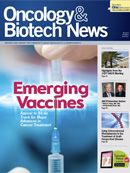Publication
Article
Oncology & Biotech News
Hedgehog Pathway Inhibitor GDC-0449 Reduces Lesion Size in Patients With Basal Cell Carcinoma
Author(s):
Patients with basal cell carcinoma had an eightfold decrease in lesion area when treated with GDC-0449

Ervin H. Epstein Jr, MD
According to the results of a placebo-controlled trial, patients with basal cell carcinoma had an eightfold decrease in lesion area when treated with GDC-0449, an investigational hedgehog pathway inhibitor. The average cumulative lesion area decreased by 24 cm compared with 3 cm in the control group (P = .006). In addition, GDC- 0449 prevented the formation of new lesions, said Ervin H. Epstein Jr, MD, at the AACR meeting in Orlando, Florida.
“We have a drug that was developed on the basis of the fundamental knowledge that hedgehog signaling is pivotal in all basal-cell carcinomas, including these patients who carried a defective copy of a gene that inhibits hedgehog signaling,” Epstein, a dermatologist at Children’s Hospital Research Institute in Oakland, California said during an AACR press briefing. “This is the first drug, in man, that replaces the function of the missing gene, and it actually works.”
Though effective, GDC- 0449 might prove difficult for some patients to tolerate, he acknowledged. About 20% of patients treated with the drug withdrew from the trial because of adverse events.

Basal Cell Carcinoma
The results capped a 15-year investigation that began when Epstein and colleagues tracked the origin of basal cell carcinoma to a mutation in PTCH, a gene subsequently found to encode a key inhibitor of the hedgehog signaling pathway. GDC-0449 blocks signaling by binding to the hedgehog ligand cell-surface receptor PTCH.
The clinical trial involved 41 patients who were randomized 2:1 to oral GDC-0449 or placebo. The primary endpoint was the number of new surgery-eligible lesions at 90 days. Epstein reported findings on 36 patients treated for at least 1 month. Patients treated with the hedgehog-pathway inhibitor developed an average of 0.07 new lesions per month, compared with 1.74 per month in the placebo group (P <.0001).
“Some patients treated with GDC-0449 had almost complete clearance of lesions,” said Epstein.
The reduction in lesion number and affected area correlated with a 200-fold decrease in the transcription activator GLI1, reflecting decreased signaling activity compared with baseline (P <.001). Placebo treatment had no effect on GLI1. Treatment with the hedgehog pathway inhibitor also was associated with a significant reduction in the Ki-67 proliferation marker but did not significantly affect levels of the apoptosis marker CC3.










